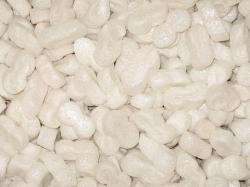May 4, 2009 weblog
Study Finds that Styrofoam Increases Biodiesel Power Output

(PhysOrg.com) -- By dissolving polystyrene packing peanuts in biodiesel, scientists have found that they can boost the power output of the fuel while getting rid of garbage at the same time.
As researchers Najeeb Kuzhiyil and Song-Charng Kong of Iowa State University explain in a recent study published in Energy and Fuels, polystyrene accounts for about 22% of all high-volume plastics, by weight. Finding a method to convert these waste plastics into energy could potentially alleviate the strain on landfills and generate electricity.
The study, funded in part by the Department of Defense, began with the goal of searching for solutions to trash disposal and power generation under battlefield conditions, where recycling is not usually an option. Although for most materials, recycling is more efficient than converting them into energy, polystyrene is so lightweight and bulky that it's uneconomical to ship to recycling plants, and may be a good candidate for fuel conversion.
In their study, the researchers used biodiesel as a recycling agent, into which they dissolved different amounts of polystyrene packing peanuts and tested the blended fuel in a tractor engine. As Kong explained, a polystyrene cup dissolves almost instantly in biodiesel, "like a snowflake in water."
By testing the fuel in a tractor engine, the scientists found that power output increased as polystyrene concentrations increased up to 5%. At concentrations above 5%, power output dropped off. As the researchers explained, polystyrene increases the biodiesel's viscosity, which initially creates greater pressure inside the generator's fuel injector that causes earlier fuel injection and increases output. But when the fuel becomes too thick, it doesn't completely combust, decreasing power output. At a polystyrene concentration of 15%, the fuel injection pump overheats.
Dissolving polystyrene in biodiesel doesn't eliminate the problem of harmful emissions, however. The scientists found that adding polystyrene increases the fuel's emissions of carbon monoxide, soot, and nitrous oxides, which don't burn completely in the engine. But the researchers hope to improve the engine's fuel injection system to achieve a more complete burn with fewer emissions. If they can reduce the emissions, they hope that the technology could offer economic and environmental advantages for power generation.
More information: Najeeb Kuzhiyil and Song-Charng Kong. "Energy Recovery from Waste Plastics by Using Blends of Biodiesel and Polystyrene in Diesel Engines." Energy and Fuels. DOI: 10.1021/ef801110j
via: New Scientist
© 2009 PhysOrg.com



















